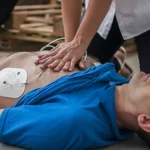Cardiac arrest is one of the leading causes of death in the United States. One reason this medical emergency is so fatal is because cardiac arrest can strike anywhere at any time—often far from a hospital or professional medical assistance. In 2015, according to a report by the Center for Disease Control and Prevention (CDC), roughly 357,000 people experienced cardiac arrest outside of a hospital. Approximately 70 to 90 percent of these individuals will never make it to a hospital to receive medical help.
What can you do to help address this health crisis? Regardless of your profession or level of medical expertise, learning CPR is one of the most effective ways you can help reduce the number of fatal cardiac arrest episodes. CPR classes can give you the knowledge, skills, and confidence to take action in the event of an emergency, and potentially, save a life.
Here at American Health Care Academy, we believe every individual should have the opportunity to gain the skills to offer assistance when someone is suffering from cardiac arrest. This is why we’re proud to offer accessible and convenient CPR certification and recertification courses that can be taken 100 percent online and even completed in a matter of hours.
In this blog, we take a closer look at how convenient it is to earn your online CPR certification. We explore some of the topics and lessons covered in these classes and learn just how easy, and fast, it is to become fully CPR certified without ever leaving the comfort of your home.
WHAT DOES A CPR COURSE INCLUDE?
Most of us are familiar with CPR, or cardiopulmonary resuscitation, to some degree. Whether learning the steps in school or seeing this procedure performed on television or in movies, CPR is a well-known technique that can keep blood and oxygen circulating throughout the body when the victim’s heart is unable to do so. This is critical to the victim’s survival rate while waiting for an ambulance to arrive.
Online CPR classes provide comprehensive instruction in how CPR affects the body, how to safely assess the situation, and then how to perform this life-saving procedure. Some CPR certification courses even teach you how to use an AED, or automated external defibrillator, that can reset a victim’s heartbeat if it becomes irregular. These combination CPR/AED classes are an excellent way to learn additional skills and save both time and money.
In addition to the steps of CPR and learning how to use an AED, some CPR certification courses include additional skills, like how to perform child and infant CPR. While many steps of the procedure are the same for a child or adult, there are key differences that need to be accounted for to perform this procedure safely. Our CPR/AED courses also include lessons on how to assist adults and children who are choking.
Our courses adhere to the updated American Heart Association’s (AHA) CPR guidelines. In 2020, the AHA made an update to their guidelines, which included instructions on performing CPR in the midst of the coronavirus pandemic. These modifications were designed to limit the amount of personnel responding to a victim, reduce exposure, and encourage bystander participation by emphasizing hands-only CPR.
HOW LONG DOES ONLINE CPR CERTIFICATION TAKE?
Compared to an in-person model, there are several reasons to choose an online CPR course. For many, speed and convenience are two qualities that simply can’t be matched by traditional courses. Instead of waiting to register for in-person classes that offer little to no control over scheduling, online CPR/AED courses put you in control of the schedule and pace of learning.
With online CPR classes, you can start and stop your training at any moment. This is particularly advantageous for people already working full-time, or if you’re in school when time is limited. While online learning is all about setting your own pace, many individuals are able to complete their course and become fully CPR certified within a matter of hours.
CPR RECERTIFICATION
After you’ve successfully earned your CPR certification, the next question for many individuals becomes: how long does CPR certification last? Whether you earn your certification online or in-person, your certification card is valid for two years. While this may seem like a short amount of time, this measure is in place to make sure that you receive the most comprehensive and up-to-date instruction. Responding to novel health issues, like coronavirus, make the need for recertification a critical one.
Luckily, receiving your online CPR recertification is just as fast and convenient as earning your initial certification. At American Health Care Academy, we offer CPR/AED certification and recertification courses so that you’ll have everything you need in one convenient place.
HOW TO PERFORM CPR
To better understand this procedure, we’re taking a moment to walk through the steps of how to perform CPR. While these steps serve as an important foundation, a complete CPR certification course will provide instruction at a much greater level of depth and detail.
Call 911.
No matter the medical emergency, the first thing you should always do is call 911. CPR is meant to be a short-term measure that keeps a cardiac arrest victim stable until medical professionals arrive on the scene.
Assess the situation.
After you call 911, assess the scenario to ensure that you don’t put yourself, or others, in harm’s way. You won’t be any good to a cardiac arrest victim if you’re also in danger. Once you’re sure that the scene is safe, you can begin performing CPR.
Position the victim.
First, you must properly position the victim. Gently roll them onto their back and kneel beside them. Open the airway by tilting their head back and lifting their chin. If you find an object obstructing their airway, such as a piece of food, remove it if the obstructing object is accessible. You don’t, however, want to force the object even further down their airway.
Check breathing.
Once the airway is open, lower your ear to their mouth to check for the victim’s breathing. If you don’t hear any breathing, begin performing CPR. If you do detect a breath, even a faint one, do not perform CPR. Continue monitoring their breathing until an ambulance arrives.
Chest compressions.
Place one hand on top of the other and lower them to the center of the victim’s chest. When performing chest compressions, push hard and fast and lead with the heel of your hand. Compressions should occur at a rate of 100 times per minute.
Rescue breaths.
Following chest compressions, tilt their head back, lift their chin, and give two rescue breaths. Watch their chest carefully. If the chest doesn’t rise after the rescue breath, you may need to reposition their airway or the victim might be choking on an object.
Repeat.
Repeat a pattern of 30 chest compressions and two rescue breaths until medical assistance reaches the scene. If another bystander is trained in CPR, you can rotate performing the procedure, ensuring no one individual becomes too tired.
THREE SIMPLE STEPS TO CPR CERTIFICATION
With online CPR certification and recertification classes, you can become fully certified in just three simple steps. Select your course, pass the test, and print off your CPR certification wallet card—it’s really that easy.
1. Select your course.
It’s important to first carefully select your course. Depending on the skills and certification you need, each course can offer unique advantages. In addition to online classes in CPR and CPR/AED, you can also select courses in First Aid, Bloodborne Pathogens, and CPR designed for healthcare providers.
2. Pass the test.
Once you’ve selected your class, you can immediately begin learning. At the end of your course, you’ll be required to pass a test. Depending on your course, this test may or may not include a hands-on assessment.
3. Print off certification.
Once you’ve passed your test, congratulations—you’re now completely CPR certified. All that’s left to do is to download and print off your certification card. Many programs even mail you a copy, as well.
CONCLUSION – HOW LONG DOES ONLINE CPR CERTIFICATION TAKE?
Each year, roughly 475,000 American lives are lost to cardiac arrest episodes. This shocking figure accounts for more deaths than auto accidents, firearms, pneumonia, and many types of cancer combined. Clearly, this is a national health crisis that must be addressed.
This is why American Health Care Academy is dedicated to equipping as many people as possible with the skills necessary to save a life in the event of a medical emergency. We have certified over 700,000 students in the past 11+ years, and we look forward to working with you next. For more information, check out our fully online certification courses, including programs in First Aid, CPR, and CPR/AED courses. Feel free to reach out anytime at 1-888-277-7865 or contact us on our website.













